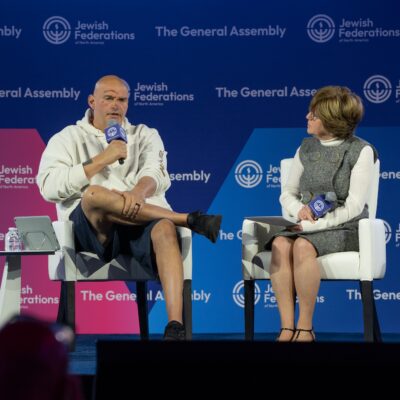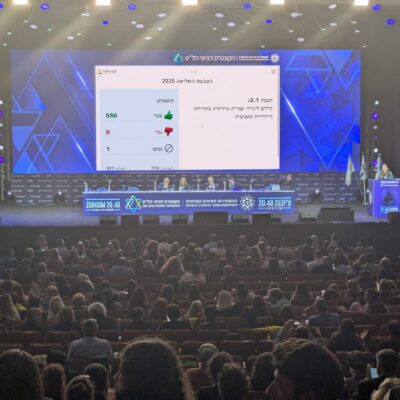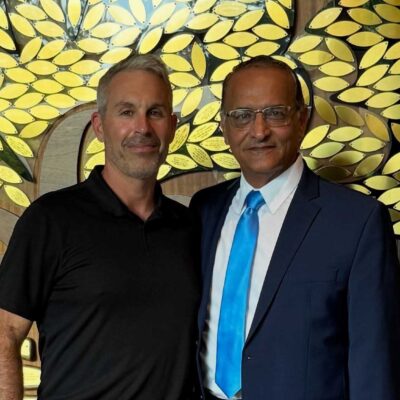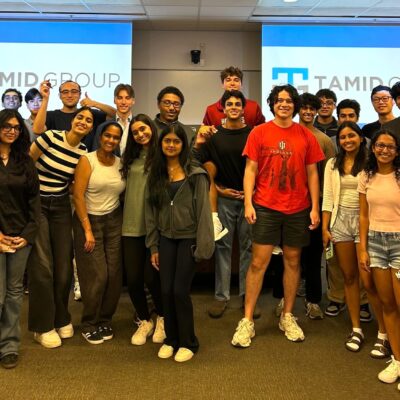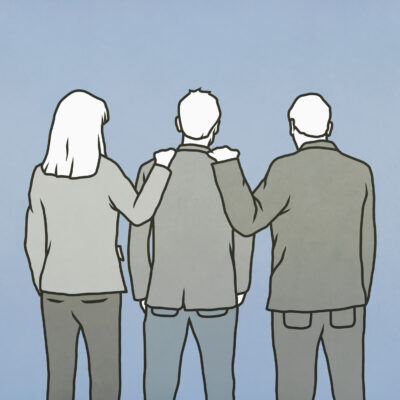CHANGING OF THE GUARD
Kibbutz Nir Oz, the hardest-hit community in the 10/7 attacks, welcomes 50 new, idealistic residents as it looks to rebuild
'Coming here, we demonstrate outwards and also to our [younger Hashomer members] from the kibbutz that the borders of Israel are important to us. That creating life in this place is important to us.'

courtesy
Young people from the Hashomer HaTzair movement move into Kibbutz Nir Oz in August 2025.
Walking along a path on Kibbutz Nir Oz, Yahel Meirovich and Raz Baruch felt the surreal contrast between the quiet birdsong, the deceptively pastoral stillness of the near-deserted kibbutz and the steady thud of bombs heard from the Gaza Strip, less than a mile away.
Part of a group of 50 young adults — all of them educators from the Hashomer HaTzair Labor Zionist youth movement — who have recently relocated to the kibbutz, the two were keenly aware of the emotional tension hanging in the air, Meirovich told eJewishPhilanthropy a week after their Aug. 3 arrival.
“This experience is steeped [in deep emotion] precisely because I know what [the kibbutz] looked like before and am seeing everything that is happening now,” said Meirovich, 27, a member of Kibbutz Negba and Hashomer HaTzair’s regional coordinator in Eshkol. “There is a wave of silence that comes because the kibbutz is empty, and you hear the booms from Gaza, which is very close. This is a tension that needs to be maintained all the time, we can’t ignore it or repress it. We feel the pulse of the war at a very high rate. The bombing in Gaza is endless, especially now that the occupation of the Gaza Strip has been declared. If we are indifferent to it, then we will get used to it. And there is no way to get used to the fact that there is a war and that there are still 50 abductees in Gaza.”
Founded in 1955 by pioneers from Hashomer HaTzair (literally, “the young guard”), Nir Oz was one of the hardest hit kibbutzim in the Oct. 7 Hamas attacks, with the Israel Defense Forces arriving only after the terrorists had already wreaked their havoc and left. A quarter of the kibbutz’s roughly 400 members were either killed or taken hostage. Nearly all of the kibbutz’s public buildings were destroyed.
Today, most of the residents of Nir Oz live in temporary housing in Kibbutz Carmei Gat near Kiryat Gat. Some veteran kibbutz members have returned to Nir Oz to guard the kibbutz and maintain the kibbutz’s agricultural work and paint factory.
With limited infrastructure available on Nir Oz, the new Hashomer HaTzair group is living in temporary housing — converted children’s houses, intact apartments and other repurposed spaces. Their move will be completed in stages, with plans for the construction of new housing beginning in the fall. They continue to work with the Nir Oz youth in Carmei Gat and also with youth from surrounding kibbutzim who have already returned to their homes.
The move of the young Hashomer HaTzair educators to Nir Oz is part of the Mefalsei Nativ (“Path Levelers”) program of Hashomer HaTzair, in partnership with Kibbutz Nir Oz with core support from the Kibbutz Movement Rehabilitation Fund — the body leading the recovery efforts of kibbutz communities in the Gaza border region since Oct.7, 2023. The Homeward Initiative, an educational foundation strengthening southern and northern communities since the war’s outbreak, has also played a key role in supporting the project from its inception as part of a broader joint effort to build young, vibrant communities in the heart of the hardest-hit kibbutzim.
“For us, the decision to move to Nir Oz is the embodiment of everything we were raised on in Hashomer HaTzair – acting together with courage and stepping in where we’re needed,” Meirovich said.
Two weeks after the Oct.7 attacks with 41 kibbutzim damaged — 22 in the south and nine in the north — the Kibbutz Movement launched the dedicated rehabilitation fund, said Neri Shotan, its CEO. The Kibbutz Rehabilitation Fund and the Homeward Initiative are the sole funders of the transition, he said.
Traditionally financed by its 259 member kibbutzim, the movement had never raised money from outside sources. Every shekel collected is directed to rehabilitation, with no funds going to movement headquarters, he emphasized. Donations have come from major Jewish federations and private donors in the U.S., Canada, England, France, Australia, and the Netherlands, with a budget totaling about $44 million (NIS 150 million) to date. Roughly $29 million (NIS 100 million) are earmarked for specific kibbutzim, while $15 million (NIS 50 million) are allocated by the fund’s leadership to address core needs: informal education, community and mental resilience, agriculture and commemoration.
The donors include the Samueli Foundation, Jewish Federations of North America, Jewish Federation of San Antonio, UJA-Federation of New York, Jewish Community Foundation of Los Angeles, Jewish National Fund-USA, American Jewish Committee, Qualcomm Foundation and the New Israel Fund.
Nir Oz, where 93% of homes were destroyed, is a central focus of the initiative, Shotan said, as Nir Oz laid a cornerstone for a new neighborhood on Aug. 7 as a sign of the kibbutz’s renewal.
Rebuilding costs for Nir Oz are estimated at $102.4 million (NIS 350 million) — $15 million more than what has been allocated by the state (including $22 million pledged by Keren Kayemeth LeIsrael-Jewish National Fund as part of its rehabilitation budget). Nevertheless, Shotam said that the Kibbutz Movement Rehabilitation Fund is determined to rebuild Nir Oz as a “bigger, stronger, and more significant kibbutz” for both the new Hashomer Hatzair group and veteran members.
“We will be there as long as necessary, both in Nir Oz and in Be’eri and… in Manara and in Misgav Am,” said Shotan, referring to kibbutzim in southern and northern Israel. “As far as we’re concerned, that’s what we’re getting up for in the morning. We very much hope this is the beginning of a larger wave.”
Their goal is to bring new families to the border areas in the north and south, he said, and already some 2,000 people have indicated interest.
Shotan said the 50 young Hashomer HaTzair graduates now in Nir Oz — working in education, agriculture and community life — are expected to encourage existing members to return. Similar initiatives are planned for other kibbutzim, and despite security and funding challenges — over $1 million for some projects — the movement is committed to restoring all affected communities. Earlier this month, officials from the 41 kibbutzim met for the first time to assess the situation, he said.
To date, they have supported more than 50 projects, some are one-time ventures while others are long-term, running for the past two years, he said.
“The move to Nir Oz… and [their decision to] be a part of the Nir Oz community, was taken out of the understanding that Nir Oz is Israel’s ‘Ground Zero,’” said Shotan.
Indeed, the decision was not taken lightly, said Baruch, 26, and the group spent a greater part of the year in discussion over the move. Moving from Kibbutz Kfar Menachem, she said that she was initially frightened by the prospect and would not have imagined herself making the move a year ago. But the conversations within the group, and the fact that they were coming together as a group, convinced her of the importance of the initiative. “We do believe that moving [to Nir Oz] will allow us to build our community and also to invite the Nir Oz community to return,” she said.
The destruction that took place in the kibbutz is still evident everywhere in its desolation and eerie silence, she said, with houses in ruins and paths leading only to empty patches of land cleared of debris. Baruch said the first time she closed the door of her room, which is the safe room of the house she shares with her partner and Meirovich, her thoughts immediately went to wondering about the last time the door was held shut.
“Being here, these are questions that grab you. All kinds of thoughts catch up with you,” she said. Some members of the group are curious about who lived in their houses before them, but she prefers not to know, she said. “We have arrived here…to create a new life here [within] the context of this place. Coming here, we demonstrate outwards and also to our [younger Hashomer members] from the kibbutz that the borders of Israel are important to us. That creating life in this place is important to us.”

 Add EJP on Google
Add EJP on Google
